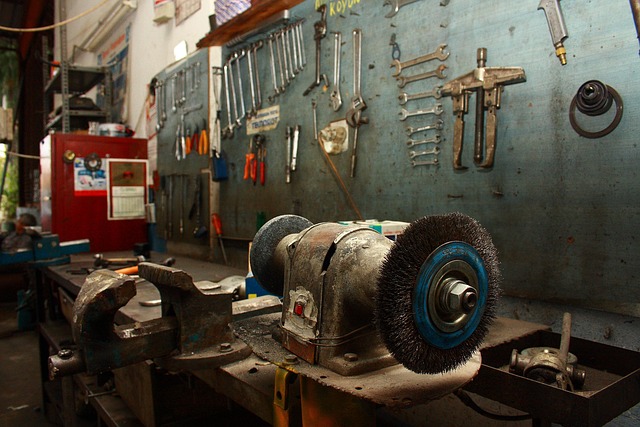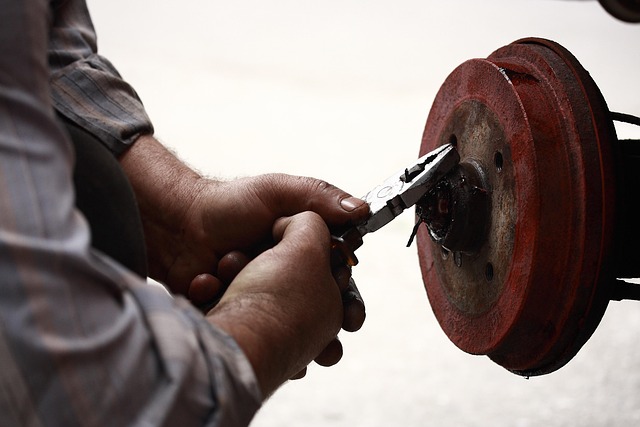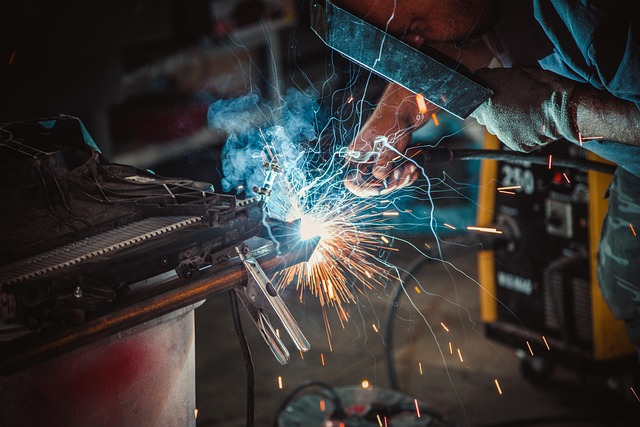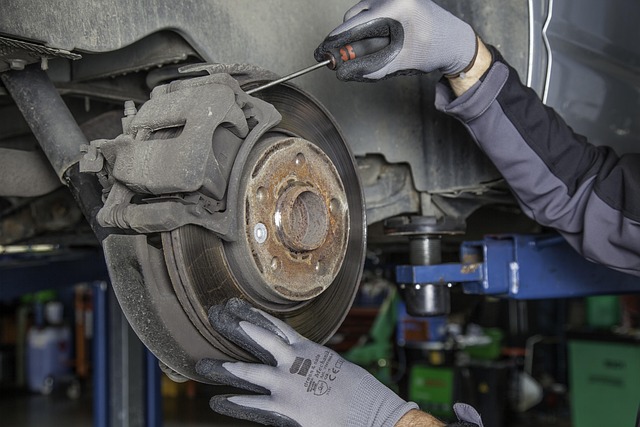Structural Integrity Restoration: Modern Vehicle Design Innovations and Challenges
Structural integrity restoration is a vital aspect of modern vehicle care, ensuring safety and stabi…….
Welcome to an in-depth exploration of a critical yet often overlooked aspect of our built world—Structural Integrity Restoration (SIR). This comprehensive article aims to guide readers through the intricate process of restoring and maintaining structural integrity, highlighting its global impact, economic implications, technological innovations, and the challenges it faces. By delving into these various facets, we will uncover why SIR is not just a technical endeavor but a vital component in shaping sustainable, resilient cities and communities worldwide.
Structural Integrity Restoration refers to the meticulous process of evaluating, repairing, and reinforcing existing structures to ensure they meet current safety standards and structural requirements. It involves a multi-disciplinary approach, combining elements of civil engineering, architecture, materials science, and construction technology. The core components of SIR include:
Structural Assessment: This initial phase involves comprehensive inspections, utilizing advanced diagnostic tools to identify weaknesses, defects, or potential failure points within the structure.
Repair and Reinforcement: Depending on the assessment findings, a range of techniques are employed to mend existing damage, strengthen weak elements, and enhance overall structural performance. These may include replacement of deteriorated materials, installation of reinforcing bars, or application of specialized coatings.
Load Analysis: Engineers carefully analyze expected loads (such as wind, snow, or seismic forces) and apply these insights to optimize the restoration design, ensuring the structure can withstand anticipated stresses.
Reinforcement Design: Utilizing advanced structural modeling software, engineers create detailed reinforcement plans tailored to the specific needs of each building, optimizing for efficiency and minimal impact on aesthetics.
The concept of structural integrity has evolved over centuries, driven by advancements in engineering knowledge and changing construction practices. Historically, many iconic structures worldwide have been restored, reflecting a growing awareness of their cultural, architectural, and economic value. The restoration movement gained momentum in the 20th century with the advent of modern materials and techniques, enabling more effective preservation and reinforcement.
Today, SIR plays a pivotal role in several key areas:
Preserving Cultural Heritage: Restoring historic buildings and monuments not only preserves architectural masterpieces but also tells the stories of our past, fostering cultural pride and tourism.
Ensuring Public Safety: As structures age, their structural integrity may decline, posing risks to occupants and passersby. SIR helps mitigate these hazards, making public spaces safer.
Promoting Sustainable Construction: By extending the lifespan of existing buildings, SIR reduces the demand for new construction, minimizing environmental impact and conserving resources.
Economic Revitalization: Restoring structural integrity can stimulate local economies, creating jobs in construction, engineering, and related fields.
Structural Integrity Restoration is a global phenomenon, with countries adopting various approaches based on their unique cultural, environmental, and economic contexts. The widespread adoption of SIR can be attributed to several factors:
Growing Awareness: Increasing awareness of structural safety and sustainability has prompted governments and organizations worldwide to prioritize SIR initiatives.
Environmental Concerns: Many regions are embracing green building practices, incorporating SIR as a key component in reducing the carbon footprint of existing structures.
Urbanization and Aging Infrastructure: Rapid urbanization puts immense pressure on existing infrastructure, making SIR essential for maintaining city resilience and livability.
| Region | Notable Trends |
|---|---|
| North America | Increasing focus on seismic retrofitting in earthquake-prone areas, with innovative solutions like base isolation and energy dissipation systems. |
| Europe | Strict building codes and stringent safety standards drive SIR, particularly in historical cities like Rome and Paris where structural preservation is a top priority. |
| Asia Pacific | Rapid urbanization coupled with a growing middle class drives demand for SIR, as seen in the restoration of ancient temples and modern skyscrapers. |
| Middle East | High-rise building construction and stringent fire safety regulations prompt extensive SIR practices to ensure structural integrity and occupant safety. |
| Latin America | Community-driven initiatives and government support are revitalizing historic centers, with SIR playing a central role in these conservation efforts. |
The Structural Integrity Restoration market is dynamic and multifaceted, influenced by various economic factors:
Building Stock and Urbanization: The size and age of a region’s building stock directly impact the demand for SIR services. Rapid urbanization drives up demand as older structures require attention.
Government Spending: Public investment in infrastructure and heritage preservation significantly influences market growth, with many countries allocating dedicated funds for SIR projects.
Cost vs. Benefit Analysis: As awareness grows, decision-makers increasingly recognize the long-term economic benefits of SIR, leading to increased investment despite initial costs.
Investment in SIR follows diverse paths:
Public Sector: Governments often fund SIR projects through dedicated budgets or public-private partnerships (PPPs), targeting critical infrastructure and cultural heritage sites.
Private Enterprise: Commercial building owners invest in SIR to enhance property value, attract tenants, and ensure tenant safety, with long-term financial benefits.
Insurance Industry: Insurance companies play a role by offering incentives for SIR, recognizing its ability to reduce risk and claim costs associated with structural failures.
The economic impact of SIR is multifaceted:
Job Creation: SIR projects stimulate employment in construction, engineering, consulting, and related trades, contributing to local economies.
Real Estate Value Enhancement: Restored structures often experience increased property values, attracting businesses and residents alike.
Tourism Boost: Historic building restorations can become tourist attractions, generating revenue for local communities.
Technological advancements have revolutionized Structural Integrity Restoration, enhancing efficiency, accuracy, and safety:
Advanced Diagnostics: Non-destructive testing (NDT) techniques, such as ultrasonic, electromagnetic, and thermal imaging, enable engineers to assess structural health without damage.
Digital Modeling and Simulation: Structural engineering software allows for complex modeling and load analysis, optimizing restoration designs and predicting performance under various conditions.
Drone Technology: Drones equipped with high-resolution cameras and sensors provide aerial inspections, accessing hard-to-reach areas and streamlining assessment processes.
3D Printing: This emerging technology offers potential for on-site fabrication of custom reinforcement elements, reducing lead times and material waste.
The future holds immense potential for technological advancements in SIR:
AI-Driven Analysis: Artificial Intelligence (AI) algorithms can analyze vast structural data, predicting failure points and optimizing repair strategies with unprecedented accuracy.
Robotic Inspection: Robotic systems equipped with advanced sensors could conduct detailed inspections, enhancing safety and accessibility in hazardous environments.
Smart Materials: Developing smart materials that adapt to changing environmental conditions could revolutionize SIR by providing self-healing or self-reinforcing capabilities.
Key policies and regulations shape the landscape of Structural Integrity Restoration:
Building Codes and Standards: Local, national, and international organizations set structural integrity standards, ensuring buildings meet minimum safety requirements.
Heritage Preservation Laws: Many countries have legislation protecting historic structures, dictating specific SIR practices for these cultural treasures.
Environmental Regulations: Environmental policies often incorporate SIR to minimize the ecological impact of construction and promote sustainable building practices.
These regulatory frameworks exert significant influence on SIR development:
Standardization: Building codes provide standardized guidelines, ensuring consistency in SIR practices across regions and disciplines.
Safety Assurance: Regulations ensure that structures meet safety standards, protecting occupants and the public.
Preservation Incentives: Heritage preservation laws encourage SIR by offering tax benefits or grants for restoring culturally significant buildings.
Despite its importance, Structural Integrity Restoration faces several challenges:
Funding and Cost Considerations: SIR can be costly, particularly for historic structures with unique architectural features. Securing funding remains a challenge, especially in resource-constrained environments.
Skill Gap: There is a growing need for skilled professionals in SIR, but the industry struggles to fill positions due to specialized knowledge requirements.
Aesthetic Concerns: Balancing structural repairs with historical preservation can be contentious, as interventions may impact a building’s aesthetic appeal.
To address these issues:
Public-Private Partnerships: Collaborating with private sector entities can bring financial resources and expertise to SIR projects, leveraging shared goals for successful outcomes.
Training and Education: Investing in training programs and educational initiatives can help bridge the skill gap, fostering a competent workforce for SIR.
Incentives and Subsidies: Governments can offer financial incentives or subsidies to encourage SIR, particularly for historic buildings, ensuring their preservation while promoting economic growth.
Challenge: The iconic Colosseum in Rome had suffered centuries of deterioration, with structural instability and unsafe conditions.
Solution: A comprehensive SIR project involved removing tons of debris, repairing the amphitheater’s walls, and reinforcing key structural elements while preserving its historical integrity.
Outcome: This meticulous restoration secured the Colosseum for future generations, attracting millions of visitors annually and becoming a testament to Italy’s commitment to cultural heritage preservation.
Context: With frequent seismic activity, Los Angeles presents unique challenges for structural integrity.
Approach: A large-scale SIR initiative focused on retrofitting high-rise buildings to withstand earthquakes, employing base isolation technology and energy dissipation systems.
Impact: This project significantly improved the seismic resilience of the city’s skyline, ensuring the safety of residents and enhancing Los Angeles’ global reputation for innovative urban planning.
Scenario: An ancient lighthouse on a remote island was in danger of collapse due to coastal erosion and neglect.
Strategy: A community-driven initiative involved SIR techniques, including structural stabilization, reinforcement with modern materials, and the implementation of conservation practices to mitigate environmental factors.
Result: The restored lighthouse became a symbol of community resilience and heritage preservation, attracting tourists and promoting environmental awareness.
The future of Structural Integrity Restoration is filled with promising trends:
Digital Twin Technology: Creating digital replicas of structures allows for virtual SIR planning and analysis, streamlining processes and enhancing design accuracy.
Sustainable Materials: The demand for eco-friendly building materials will grow, driving innovation in SIR to incorporate sustainable solutions.
Predictive Maintenance: AI and IoT sensors can monitor structural health in real time, enabling predictive maintenance and proactive SIR strategies.
Several areas are poised for significant growth:
Smart Cities: As cities embrace smart technology, SIR will play a crucial role in ensuring the structural integrity of intelligent infrastructure like smart grids and connected buildings.
Infrastructure Renewal: Aging critical infrastructure demands substantial investment, creating opportunities for SIR projects to revitalize transportation networks, bridges, and water treatment facilities.
Cultural Heritage Preservation: With a growing appreciation for cultural heritage, SIR will remain essential in restoring and safeguarding historic sites worldwide.
In conclusion, Structural Integrity Restoration is more than just a technical endeavor; it is a catalyst for positive change, shaping the built environment in profound ways. As cities continue to grow and evolve, the need for SIR will remain paramount. By embracing technological advancements, implementing effective policies, and addressing challenges head-on, we can ensure that our structures stand strong, safe, and sustainable for generations to come.
Q: How do I know if my building needs Structural Integrity Restoration?
A: If you notice cracks in walls or foundations, uneven floors, sticky doors or windows, or signs of water damage, it may indicate structural issues that require SIR. Professional assessments are crucial for accurate diagnosis.
Q: What is the difference between SIR and structural repair?
A: Structural Integrity Restoration focuses on ensuring overall structural integrity and safety, often involving system-wide repairs and reinforcement. Structural repair, in contrast, addresses specific damaged areas without necessarily assessing the broader structural health.
Q: Can SIR be done while a building is occupied?
A: Yes, SIR can be conducted while a building remains occupied, but it requires careful planning, temporary solutions, and coordination with occupants to ensure safety and minimize disruptions.
Q: How do I choose the right SIR contractors?
A: Look for experienced, licensed, and insured contractors with a proven track record in SIR projects similar to yours. Request references, check reviews, and ensure they comply with local building codes and regulations.
Q: Are there tax benefits for SIR projects?
A: Yes, many countries offer tax incentives or grants for SIR, particularly for historic structures. Consult your local tax authority or a financial advisor to explore available benefits.

Structural integrity restoration is a vital aspect of modern vehicle care, ensuring safety and stabi…….

Structural integrity restoration is crucial for securing the safety and longevity of buildings, home…….

Electric vehicles (EVs) are transforming transportation, but maintaining their structural integrity…….

After a collision, achieving structural integrity restoration is crucial for vehicle safety and reli…….

Structural Integrity Restoration (SIR) is a meticulous process that strengthens and repairs damaged…….

Structural Integrity Restoration (SIR) is a meticulous process that revitalizes and strengthens crit…….

Structural integrity restoration is a specialized process that returns damaged structures, particula…….

Structural integrity restoration is a meticulous process that revives buildings and frames to their…….

After catastrophic events like auto collisions, skilled restorers assess structures using visual ins…….